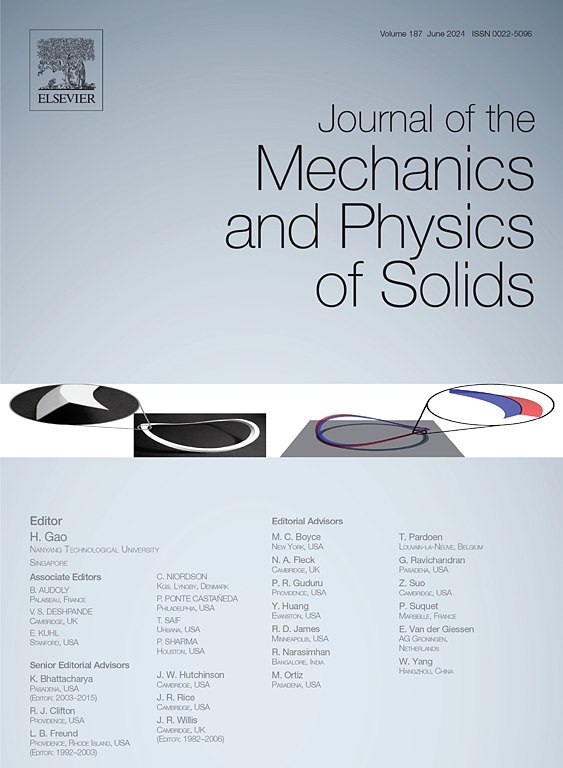Multiple scales homogenisation of a porous viscoelastic material with rigid inclusions: Application to lithium-ion battery electrodes
IF 5
2区 工程技术
Q2 MATERIALS SCIENCE, MULTIDISCIPLINARY
引用次数: 0
Abstract
This paper explores the mechanical behaviour of the composite materials used in modern lithium-ion battery electrodes. These contain relatively high modulus active particle inclusions within a two-component matrix of liquid electrolyte which penetrates the pore space within a viscoelastic polymer binder. Deformations are driven by a combination of (i) swelling/contraction of the electrode particles in response to lithium insertion/extraction, (ii) swelling of the binder as it absorbs electrolyte, (iii) external loading and (iv) flow of the electrolyte within the pores. We derive the macroscale response of the composite using systematic multiple scales homogenisation by exploiting the disparity in lengthscales associated with the size of an electrode particle and the electrode as a whole. The resulting effective model accurately replicates the behaviour of the original model (as is demonstrated by a series of relevant case studies) but, crucially, is markedly simpler and hence cheaper to solve. This has significant practical value because it facilitates low-cost, realistic computations of the mechanical states of battery electrodes, thereby allowing model-assisted development of battery designs that are better able to withstand the mechanical abuse encountered in practice and ultimately paving the way for longer-lasting batteries.
具有刚性内含物的多孔粘弹性材料的多尺度均匀化:在锂离子电池电极上的应用
本文探讨了用于现代锂离子电池电极的复合材料的力学行为。它们在液体电解质的双组分基质中含有相对高模量的活性颗粒包裹体,该液体电解质穿透粘弹性聚合物粘合剂内的孔隙空间。变形是由以下因素共同驱动的:(i)电极颗粒在锂插入/提取时的膨胀/收缩,(ii)粘结剂在吸收电解质时的膨胀,(iii)外部负载和(iv)孔隙内电解质的流动。我们通过利用与电极颗粒和电极作为一个整体的尺寸相关的长度尺度的差异,利用系统的多尺度均质化来推导复合材料的宏观尺度响应。由此产生的有效模型准确地复制了原始模型的行为(正如一系列相关案例研究所证明的那样),但至关重要的是,它明显更简单,因此求解成本更低。这具有重要的实用价值,因为它促进了电池电极机械状态的低成本、现实计算,从而使模型辅助开发的电池设计能够更好地承受在实践中遇到的机械滥用,并最终为更持久的电池铺平道路。
本文章由计算机程序翻译,如有差异,请以英文原文为准。
求助全文
约1分钟内获得全文
求助全文
来源期刊
CiteScore
9.80
自引率
9.40%
发文量
276
审稿时长
52 days
期刊介绍:
The aim of Journal of The Mechanics and Physics of Solids is to publish research of the highest quality and of lasting significance on the mechanics of solids. The scope is broad, from fundamental concepts in mechanics to the analysis of novel phenomena and applications. Solids are interpreted broadly to include both hard and soft materials as well as natural and synthetic structures. The approach can be theoretical, experimental or computational.This research activity sits within engineering science and the allied areas of applied mathematics, materials science, bio-mechanics, applied physics, and geophysics.
The Journal was founded in 1952 by Rodney Hill, who was its Editor-in-Chief until 1968. The topics of interest to the Journal evolve with developments in the subject but its basic ethos remains the same: to publish research of the highest quality relating to the mechanics of solids. Thus, emphasis is placed on the development of fundamental concepts of mechanics and novel applications of these concepts based on theoretical, experimental or computational approaches, drawing upon the various branches of engineering science and the allied areas within applied mathematics, materials science, structural engineering, applied physics, and geophysics.
The main purpose of the Journal is to foster scientific understanding of the processes of deformation and mechanical failure of all solid materials, both technological and natural, and the connections between these processes and their underlying physical mechanisms. In this sense, the content of the Journal should reflect the current state of the discipline in analysis, experimental observation, and numerical simulation. In the interest of achieving this goal, authors are encouraged to consider the significance of their contributions for the field of mechanics and the implications of their results, in addition to describing the details of their work.

 求助内容:
求助内容: 应助结果提醒方式:
应助结果提醒方式:


